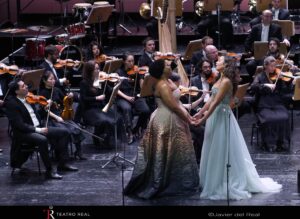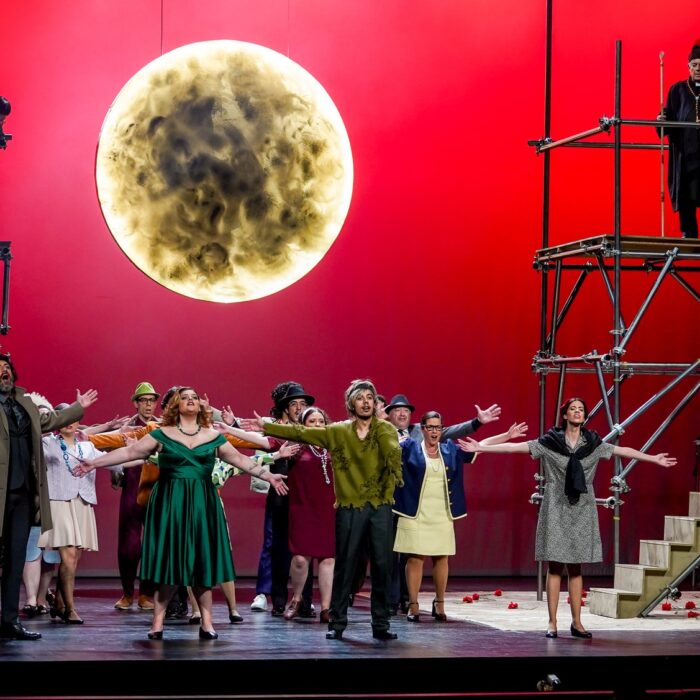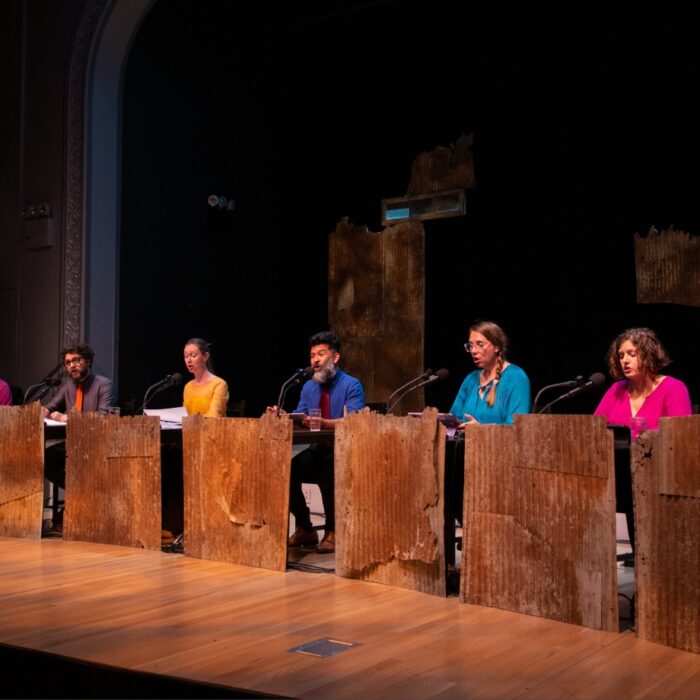
Teatro Real 2023-24 Review: Nadine Sierra & Pretty Yende’s Recital
By Mauricio VillaNadine Sierra obtained a great success last season with Bellini’s “La sonnambula,” which by chance was the opening aria of Yende in this concert. But, Pretty Yende made her house debut in Madrid. Both of them are greatly acclaimed around the world and we can say that they are in the top ten list of the best sopranos today. They have been touring with this recital for a while, and it shows for the enormous mutual understanding and chemistry on stage, as it showed the interpretation of the duet from the second act of Bellini’s Norma: “Mira, o Norma…” where not only their voices melted perfectly together, but their interaction and projection was astonishing. They sang Bel Canto arias in the first part and “popular” and “musical theatre “songs in the second part. Singing a unique but long encore which was a medley of several musical pieces like “Edelweiss” and “Over the rainbow”.
The lyrico leggera South African soprano Pretty Yende opened after the interpretation of Rossini’ overture from “The Barber of Seville” during the concert with the long final scene of Bellini’s “La somnambule,” “Ah! Se una volta sola…” Her voice’s projection during the long recitative was mesmerizing, the A flat of “Non mirar” was ringing in one’s ears. With her dark and big sound, she coloured her voice through Bellini’s expansive melodies portraying the somnambulist naïve girl. The interpretation of the aria “Ah! Non credea mirarti…” was very moving and continuous with long legato lines. The soprano was visibly comfortable with Bellini’s central writing. The cabaletta “Ah! non giunge” was a showcase of fast scales, roulades, trills and staccato high notes up to E flat. Yende has a depurated Bel Canto technique, so her coloratura was clean and secure, but the growth of her voice has paid its toll on the upper region of her register, and so she passed through the several E flats without holding any of them.
Her interpretation of Olympia’s aria from “Les contes d’Hofmann”: “Les oiseaux dans la charmille…” proved just the same, immaculate Bel canto technique but only staccato high notes not going higher than E flat (avoiding the variations going up to high F that she used to sing). But several notes were a bit flat, and her sustained last E flat sounded plain, strained and too short. It was no surprise at all that in all the duets with Sierra, Yende sang the mezzo soprano lines like “Mira o Norma” or Delibe’s “Sous le dôme épais” where her dark big voice sounded bright and comfortable.
The audience appreciated the effort of the soprano singing two Spanish Zarzuela pieces from “La Tempranica”: “Sierras de Granada” and “La tarantula e un bicho mu malo” in the second part with a dubious unclean Spanish diction. She ended her solo interpretations of the concert with the joyful “Art is calling for me” from “The Enchantress.” It was in general an incredible presentation of the soprano in the Spanish opera coliseum, but it doesn’t surprise me that she will turn her career into lyrical roles, abandoning the coloratura roles she has been singing until now. She has announced that she will debut Leonora in Verdi’s “Il Trovatore.”
The American soprano Nadine Sierra’s first interpretation was the duet from the second act of “Norma,” “Mira o Norma,” which was a perfect piece to warm up the voice on the stage as she sang along Pretty Yende and her voice was not exposed. As the duet was performed in the original key (it is usually sung one tone lower when Adalgisa is sang by a mezzo soprano or Norma by a dramatic soprano) she had several ascensions to B flats and high Cs. Her velvet bright voice carries perfectly along Yendes big instrument.
Her first solo intervention was Violetta’s first long act aria “E strano…Ah! Forse lui…Sempre libera” and this is a piece that she knows well as Violetta is one of her signature roles. It seemed so easy and natural that you forgot the difficulties of this piece: the devilish coloratura, the high Cs and D flats, as her top notes sounded secure, supported, and strong. She interpolated a beautiful D flat and high C in the cadenza of the aria and finished the piece with a top ringing E flat. But it wasn’t only vocal fireworks, the big contrast was between the strong fortissimo “per l’aride follie” and the whispering “del viver mio” which was hair raising. She navigated effortlessly and easily through the long legato lines, with incredible soaring pianissimi and strong ringing fortes. But above all it shined because of her remarkable interpretation: her initial doubts, her rendition for love, her fight against her own feelings that culminated the cabaletta. One could tell she was always in character, showing her own vision of Violetta. It is anecdotic that Pretty Yende sang Alfredo’s lines off stage in “Sempre libera,” adding a high C to the melody “Croce e delizia”
Her next solo piece was Julieta’s first act waltz from Gounod’s masterpiece (a role she had just performed at the Met). Her interpretation was lively, joyful, and explosive. She accomplished once more with the coloratura demands, the fast scales and high notes but this was always to the service of her interpretation which was the portrayal of a naïve and innocent sweet girl.
The first part ended with the famous flower duet from Delibe’s “Lakme,” where the voices of both sopranos navigated soaring through the floating long melody and whose voices were in perfect balance and melted perfectly. They ended the duet singing the last lines off-stage as it is usually staged in performances.
As her colleague did, Sierra offered two songs in Spanish for the second part, “Me llaman la primorosa” from the zarzuela “El barber de Sevilla” and the popular song “Bésame mucho” from Consuelo Velazquez.” Her Spanish diction was clear and secure, and once more you could see that the soprano was enjoying the performance, based on her gestures and how she rejoiced with each line.
After a strong ovation from the audience the sopranos offered a single long encore which was a medley of classics like “Edelweis” and “Over the rainbow.”
The conductor Pablo Mielgo accomplished following the sopranos, breathing with them and exploiting all the timbre potential of the several pieces, which is what you expect from a conductor from a soloist concert. With the orchestra of Teatro Real, they offered an amusing overture of Rossini’s “The barber of Seville,” the prelude of the zarzuela “El tambor de Granaderos” and the amusing overture from Berstein’s “Candide.” One might have expected Sierra would sing the famous aria “Glitter and be Gay.” The orchestra sounded bright and powerful without undermining the voices of the sopranos.
It was a memorable night. It is not common to hear two top sopranos sharing the stage with such enthusiasm and humility. It was a perfect presentation of Pretty Yende at Teatro Real and it reaffirmed Sierra as one of the favourites from the Madrid’s audience.


